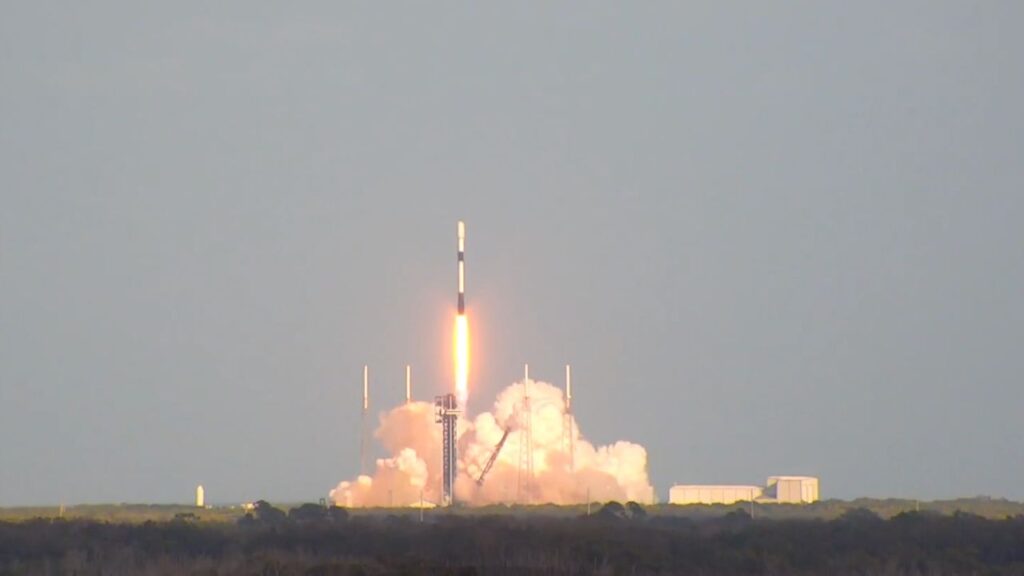Now, SpaceX has done it again. Under the leadership of Elon Musk, the aerospace Elon Musk giant continues to strengthen its position in space exploration and telecommunications. Earlier today, they achieved another notable milestone by sending another batch of Starlink satellites into orbit. This launch demonstrates SpaceX’s pursuit of expanding internet access globally and shows the advancements in satellite technology.
What exactly is so unique about this particular launch? From its technical aspects to its broader scope, this post will explain everything you need to know about today’s achievement.
Highlights of Today’s Starlink Satellite Launch
The most recent Starlink satellite launch by SpaceX occurred without a hitch on Sunday, April 27, 2025, at 10:09 PM EDT (0209 GMT April 28) from Cape Canaveral Space Force Station, Florida. This marked the 250th dedicated Starlink launch for SpaceX, yet another testament to the company’s growth and dominance in the commercial space industry.
The Falcon 9 rocket successfully deployed 23 new Starlink satellites into low Earth orbit, including 13 with direct-to-cell capabilities for enhancing global mobile services.
During this mission, the Falcon 9’s first-stage booster, B1077, completed its 20th flight. It landed perfectly on the autonomous drone ship “Just Read the Instructions” in the Atlantic Ocean roughly eight minutes after the launch.
This marked the 48th Falcon 9 flight in 2025 and the 31st flight allocated to expanding the Starlink mega constellation, which now consists of over 7200 operational satellites.

Why do we care about their launches?
It’s More than Just Another Rocket Launch
SpaceX continues to demonstrate its capacity to balance efficiency with operational scale, and this mission is no different. Here’s why it matters:
Economic Factors: Reusing the rocket will reduce costs and expand the Falcon 9 industrial base.
Environmental Focus: Balanced wastage of resources reduces the need for new equipment units and tackles the escalating climate emergency.
Scientific and Global Collaboration: Lower prices attract commercial and governmental organizations and advocate structural global collaboration, uniting different nations towards a singular goal.
SpaceX is changing the world of space travel as we know it!
Mission Objectives For Today’s Launch
This mission’s primary objective is to further expand the Starlink constellation network of satellites in low Earth orbit (LEO), designed to deliver high-speed internet services globally. The newly launched batch of satellites will add to the more than 6,000 operational Starlink satellites already in orbit, advancing SpaceX’s progress toward achieving worldwide internet coverage.
The key objectives of this particular launch include:
Expanding Coverage of the Internet: Providing Internet access to unserved and rural regions that lack the most basic telecommunications infrastructure.
Improving Network Configuration: Enhancing customers’ experience by reducing the latency and increasing the bandwidth with denser satellite coverage.
Testing New Functions: Deploying satellites with inter-satellite laser links for quicker data transfer.
Starlink Satellite Deployment Processes
Launch and Initial Deployment
Starlink satellites are launched in batches using SpaceX’s Falcon 9 rocket. After reaching space, the rocket’s second stage spins before releasing the stack of satellites, giving each one a slightly different velocity to aid dispersal after deployment 34. Each satellite is placed in a ‘parking orbit’ at approximately 270 miles (440 km) above Earth78 for the initial deployment phase.
Separation and Early Operations
As satellites are released, they deploy solar arrays and slowly separate due to the gradual velocity changes imparted during the deployment.
Over the next few days and weeks, each satellite employs its onboard Hall-effect ion thrusters for gradual orbit raising, achieving an operational altitude of approximately 550 km.
The satellites are in a close cluster during this phase, making them more visible, and can often be seen as a “train” of lights from the ground at night.
Final Positioning
They use their thrusters to spread out and manoeuvre into their assigned slots within the Starlink constellation, providing the constellation with global coverage.
After reaching the required position, they begin on-station service by relaying internet data between ground stations and users.
Summary Table
| Step | Description |
|---|---|
| Launch | Falcon 9 carries batch of satellites to space |
| Deployment | Second stage spins, satellites released into parking orbit |
| Solar Panel Deployment | Satellites unfurl solar panels and drift apart |
| Orbit Raising | Onboard ion thrusters boost satellites to final operational altitude |
| Final Constellation Slot | Satellites manoeuvre into precise positions for network coverage |
This process allows SpaceX to efficiently and rapidly expand the Starlink constellation, enabling broad internet coverage worldwide.
The Effect of Starlink and SpaceX Occupying the Same Band
Extending Internet Access to Everyone
Starlink’s mission is focused on bridging the gap in regions that lack proper internet access. Millions of users face internet access problems in remote places and underprivileged countries. With Starlink’s satellites deployed in low Earth orbit(Low Earth Orbit) satellite constellations, it shall enable internet service connectivity and coverage with broadband and low latency. This unprecedented change would transform the education and healthcare sectors and even accelerate the financial growth of the isolated parts of the country.
Last but not least, the Starlink satellites can provide internet access on aircraft and vessels, and we look forward to serving the defence forces.
Fueling the Competition for Outer Space
Apart from that, SpaceX seeks to use Starlink for its comprehensive purposes and aims to increase the satellite constellation under its belt to 42,000 over the next decade. This would catalyze SpaceX to lead the market in satellite internet services and provide access to high-speed internet across the globe.
This order of business is in addition to SpaceX interconnecting the satellites with telecom 5G services, collaborating with other telephone operators across the globe, and enabling telecommunication services for upcoming Mars missions. SpaceX has made plans to extend the borders of Earth.
For the latest news regarding SpaceX and Starlink, visit SpaceX’s web page to look up the latest service updates.
Achievement Perspective
These remarkable accomplishments of SpaceX have brought boundless opportunities, claiming a sizeable leap in technology.
They embody a future from which innovation, determination, and a bold outlook transform how we think about connectivity and access.
Today’s Starlink launch demonstrates SpaceX’s unrelenting focus on new technology and its willingness to push boundaries within the aerospace and telecom sectors. Each new accomplishment moves the world nearer to universal internet connectivity.
What do you think about the future of space and technology? We hope you are as enthusiastic as we are, and we will all follow SpaceX as it moves towards even more extraordinary goals.
For the latest status updates on SpaceX and Starlink, keep an eye on SpaceX’s Official Website.
You may read this: Beauty and Power of Natural Lightning You Have to See to Believe















